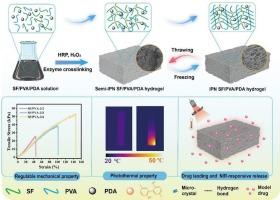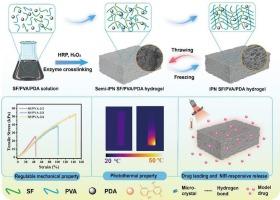Regulable preparation of PDA-integrated silk fibroin/polyvinyl alcohol composite hydrogels with interpenetrating network for NIR-triggered drug release
IF 4.3
2区 工程技术
Q2 ENGINEERING, CHEMICAL
引用次数: 0
Abstract
The modulation of structural and mechanical properties through construction of interpenetrating (IPN) hydrogels offers significant potential for expanding their applications as drug carriers. In this study, a silk fibroin (SF)/Polyvinyl alcohol (PVA)/polydopamine particles (PDA) hydrogel with IPN structure for near-infrared (NIR)-responsive controlled release of drugs were prepared by combining enzyme crosslinking with freeze–thaw cycles treatment. Compared with SF/PVA hydrogels prepared solely by enzyme crosslinking, the IPN hydrogels exhibited enhanced stability, a more ordered pore structure, and improved mechanical property. The hydrogels withstood 90 % of compressive deformation without breaking, and the maximum tensile strain at break reached 140.07 %. Moreover, the mechanical properties of the hydrogels were tunable by adjusting the ratio and concentration of SF and PVA. The incorporation of PDA particles into the IPN SF/PVA hydrogel endowed the material with excellent NIR responsiveness. Upon 808 nm NIR irradiation for 10 min, the temperature increased by 19.8°C, with stable photothermal conversion performance maintained over three irradiation cycles. In addition, SF/PVA/PDA hydrogels exhibited good biocompatibility and NIR-responsive drug release capability. These findings highlight the potential of this SF/PVA/PDA hydrogel as a promising material for drug-controlled release applications.


具有互穿网络的pda集成丝素/聚乙烯醇复合水凝胶的可调节制备,用于nir触发的药物释放
通过构建互穿(IPN)水凝胶来调节结构和力学性能,为扩大其作为药物载体的应用提供了巨大的潜力。本研究采用酶交联和冻融循环处理相结合的方法,制备了具有IPN结构的丝素(SF)/聚乙烯醇(PVA)/聚多巴胺颗粒(PDA)水凝胶,用于近红外(NIR)药物的响应控释。与单酶交联制备的SF/PVA水凝胶相比,IPN水凝胶稳定性增强,孔隙结构更有序,力学性能也有所改善。水凝胶在不破裂的情况下承受了90% %的压缩变形,破裂时的最大拉伸应变达到140.07 %。此外,还可以通过调节SF和PVA的比例和浓度来调节水凝胶的力学性能。将PDA颗粒掺入IPN SF/PVA水凝胶中,使该材料具有优异的近红外响应性。808 nm近红外照射10 min后,温度升高19.8°C,在三个照射周期内保持稳定的光热转换性能。此外,SF/PVA/PDA水凝胶具有良好的生物相容性和nir反应性释药能力。这些发现突出了SF/PVA/PDA水凝胶作为药物控释材料的潜力。
本文章由计算机程序翻译,如有差异,请以英文原文为准。
求助全文
约1分钟内获得全文
求助全文
来源期刊

Chemical Engineering Science
工程技术-工程:化工
CiteScore
7.50
自引率
8.50%
发文量
1025
审稿时长
50 days
期刊介绍:
Chemical engineering enables the transformation of natural resources and energy into useful products for society. It draws on and applies natural sciences, mathematics and economics, and has developed fundamental engineering science that underpins the discipline.
Chemical Engineering Science (CES) has been publishing papers on the fundamentals of chemical engineering since 1951. CES is the platform where the most significant advances in the discipline have ever since been published. Chemical Engineering Science has accompanied and sustained chemical engineering through its development into the vibrant and broad scientific discipline it is today.
 求助内容:
求助内容: 应助结果提醒方式:
应助结果提醒方式:


